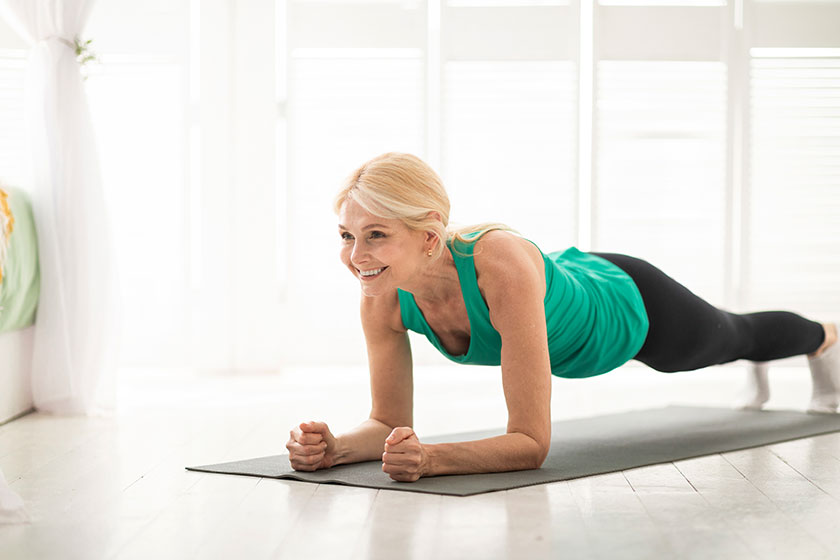Engaging in core strengthening exercises is essential for maintaining health and independence as we age. A robust core supports various aspects of daily life, from improving mobility to enhancing stability. Here, we outline the most significant core exercises benefits for seniors that can help you maintain vitality and function, especially if you have just started out on your retirement journey.
What Are Core Exercises?
Core exercises are targeted physical activities designed to strengthen and tone the muscles in the core region of the body, which includes the abdomen, lower back, hips and pelvis. These exercises focus on improving the stability and strength of the core muscles, which play a pivotal role in virtually every movement of the human body.
Core workouts often involve exercises like planks, sit-ups, abdominal crunches and leg lifts, which help improve posture, balance and overall fitness. In addition to building stronger muscles, engaging in core exercises enhances functional movement used in daily activities and sports, providing a foundation for a healthier, more active lifestyle.
Better Balance and Stability
A strong core is your foundation for balance and stability and it therefore has the potential to reduce the risk of falls. Core exercises strengthen the muscles around your lower back, hips and abdomen, areas that help in maintaining your center of gravity. This training allows you to navigate uneven surfaces and react swiftly to any shifts in balance, providing you with the confidence to engage in various activities without fear of falling.
Improved Posture
Maintaining a strong core helps in maintaining a correct posture. As you strengthen the muscles around your spine, you naturally reduce the slump often associated with age, promoting a more upright and aligned posture. This improves your appearance and alleviates stress on your spine, reducing the likelihood of back pain and other complications related to poor posture.
Increased Mobility and Flexibility
Core exercises can also increase your range of motion and flexibility. By engaging and strengthening the entire midsection, you enhance your body’s ability to bend, twist and reach, making daily tasks such as tying shoes, reaching for items or looking over your shoulder much easier. This increased mobility can significantly enhance your quality of life by keeping you active and capable of performing various tasks independently.
Reduced Back Pain
Back pain is a common issue that can significantly hinder your lifestyle, but strengthening your core can help alleviate this problem. A robust core supports your spine, helping distribute weight evenly and reducing pressure on your lower back. Regular core exercises can decrease the chances of back pain by ensuring that your spine is supported properly, especially during physical activities.
Better Overall Physical Fitness
Core strength is integral to overall physical fitness. It enhances your ability to engage in other forms of exercise, from walking to more intense fitness activities like cycling or swimming. A strong core also improves your endurance and power, which are important for maintaining an active lifestyle. This increased fitness level helps you keep up with your daily routine and improves your resilience against illnesses and the physical challenges of aging.
Improved Digestive Function
Engaging your core muscles regularly can also have positive effects on your internal organs, particularly your digestive system. Exercises that involve the core muscles can help increase blood flow and assist in the movement of digested food through your intestines. This can lead to improved digestion and reduced digestive discomfort, which is a common issue in the golden years.
Increased Metabolic Rate
Core workouts do more than just build muscles—they also help in boosting your metabolic rate. Your body’s natural metabolic rate slows with age. By incorporating regular core strengthening exercises, you can help keep the rate high and thus maintain a healthier weight and reduce the risk of obesity-related health issues.
Stress Reduction and Mental Health Benefits
Physical activity, including core exercises, is well-known for its ability to reduce stress and improve mental health. Engaging in a regular exercise routine can lead to the release of endorphins, the body’s natural painkillers and mood elevators. Strengthening your core can also contribute to better sleep quality and a more relaxed state of mind, both of which are vital for your overall well-being during retirement.
Improved Respiratory Function
Core exercises play a significant role in improving respiratory function. The diaphragm, a major muscle involved in breathing, is part of the core. Strengthening the core muscles, including the diaphragm, can enhance lung capacity and efficiency.
This is particularly beneficial as you age, ensuring that your body can receive adequate oxygen during both rest and activity. Enhanced respiratory function is crucial for maintaining stamina and overall health, allowing you to engage more actively in daily activities and exercise with greater ease and less fatigue.
Making Core Exercises Part of Your Daily Routine
Incorporating core exercises into your daily routine is a proactive step toward maintaining your independence and health in retirement. These exercises provide a foundation for physical activity and daily functions, enhancing your stability, posture, mobility and overall fitness. Whether you’re currently in retirement or about to make the transition, integrating core strengthening into your routine can dramatically improve your quality of life as you age.







